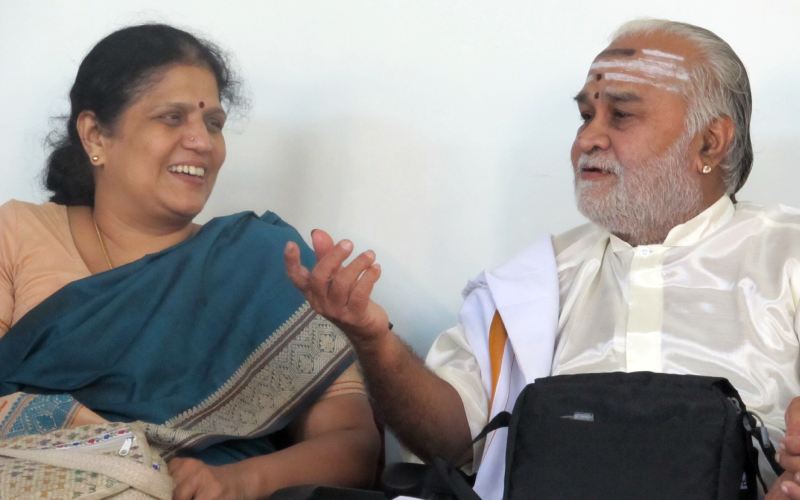
“Nothing would have been possible without guru and God’s grace,” Sukkanya Ramgopal opened the confabulating conversation with a humble note. A person turns to a personality only through continuous learning and gaining the required qualities in life to achieve that state. Those precious ones make them unique and help them taste the clouds of success. This interesting dialogue with the first woman ghatam player, Sukkanya Ramgopal, brings to us many open-secrets, hardships, and her scintillas of achievements.
Sukkanya was born as the fifth child to Subramaniam and Ranganayaki at her maternal native place, Mayilaaduthurai. Her great grandfather was Thamizh Thaathaa, Dr. U. Ve. Swaminatha Iyer, and his efforts in transforming the Thamizh manuscripts to paperback books earned him the title. It could be considered as the greatest service done for the Thamizh language as such.
Her initial education took place at a Montessori School near her residence and further continued at National Girl’s High School. She had done her P. U. C. from Ethiraj College at Chennai. After a break of one year, she furthered her Under-graduation in B. Sc. Mathematics from S. I. E. T. College. Sukkanya’s music guru, Vidwaan Harihara Sharma’s, house was located in the same lane where her home stood. She also fondly recalled the name of her house as Thyagaraja Vilaasam at Pillayaar Kovil Street.
“I learnt music along with my sister, Banumathi from Thazhakudi Ayyasaami Iyer, student of Rajam Iyer. He came to our home and taught us the classes. Even when I had been learning to sing classical songs, I had a peculiar interest for percussion instruments. There was a strong invisible connection that was constantly pulling me towards them. I experienced a sense of blissfulness when I heard the percussion instruments even on radio. Eventually, I learnt Violin from Dhanapalan Sir and Vikku Sir’s brother, T. H. Gurumoorthy Sir.”
Sukkanya’s strange passion towards the percussion instruments grew with time. She regularly observed the percussion instruments classes happening in Sri Jaya Ganesh Tala Vadya Vidyalaya which was located just opposite to the residence of Vidwaan Vikku Vinayakram. Sukkanya, in fact, exclaimed that she would stand wonderstruck at the place where she hears a beat of mridhangam. The artist said that she enjoyed those moments completely and to extend the bliss experienced, she used to ask her sister to sing and accompanied the song with a percussion using a steel vessel at home.
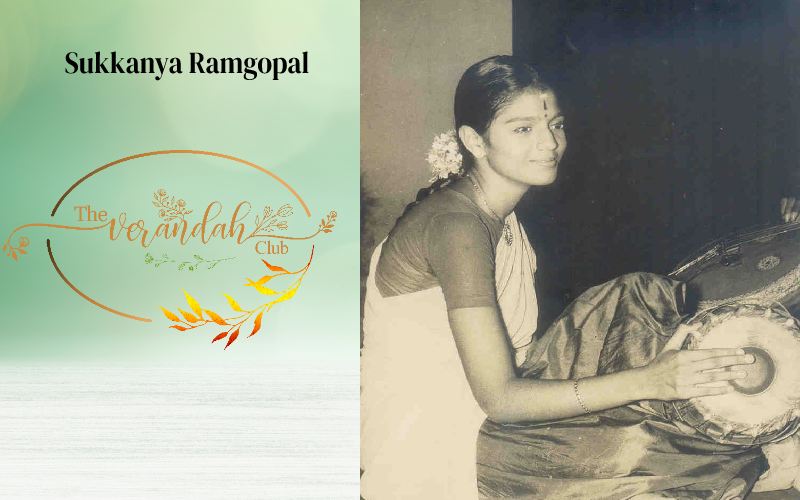
“At the time of Pongal, there happened fairs in my villages during which instruments like ganjira, and udukkai made out of clay were sold. I bought those instruments with the money that amma gave me and played it secretly. Even though I was learning violin from Gurumoorthy Sir, my love for mridhangam grew with time. It seemed that my thirst for beats could be quenched by learning mridhangam.”
Girls who belonged to the days of yore were kept away from percussion instruments, perhaps, due to their humble physique. Sukkanya had felt hesitant to request her father to allow her to learn mridhangam. However, she succeeded in confessing her mind to her mother who was glad about the same. And it so happened to Sukkanya one day…
“I had approached Harihara Sharma Sir and expressed my wish to learn mridhangam. I also told him that I had informed my mother about my wish to learn mridhangam. So, he instantly asked me to sit and agreed to teach. I could not believe that moment, it was just like my dream had come true. Now, I realize, is it not but a divine plan which had set the stage for my future endeavour and the right alignment of the stars set to create landmarks in future?” Sukkanya wondered while sharing her best moments.
It was amazing to see a person who spoke at length about the greatness of her guru, Harihara Sharma. Indeed, this is one of the qualities which makes a person down to earth. Realizing that the vidya which the guru had taught really is eternal and it is guru who becomes the right instrument to transmit that knowledge. This awareness helps everyone to grow humble, which is our nature.
The ghatam performer claimed that the days of the week did not matter, and students would throng even during the weekends as the masters had been handling the classes with much interest and proficiency. They would take classes in groups for students according to their level of performance. Within three years of rigorous training, Sukkanya had got the opportunity to perform on small stage programs in and around Tamil Nadu. She had also participated in competitions conducted by Eyal Isai Nataka Manram.
Sukkanya Ramgopal continued to reminisce, “Vikku Sir’s maternal uncle was K. C. Thyagarajan. He was a sangeetha vidwaan who worked with All India Radio as a program executive and had gained many precious awards. He also used to perform Kadhaakaalakshemam (Traditional storytelling accompanied with musical instruments) and for one such program he asked me to accompany him. I played either dolak or mridhangam depending upon the requirement and K. C. Sir would encourage me a lot.”
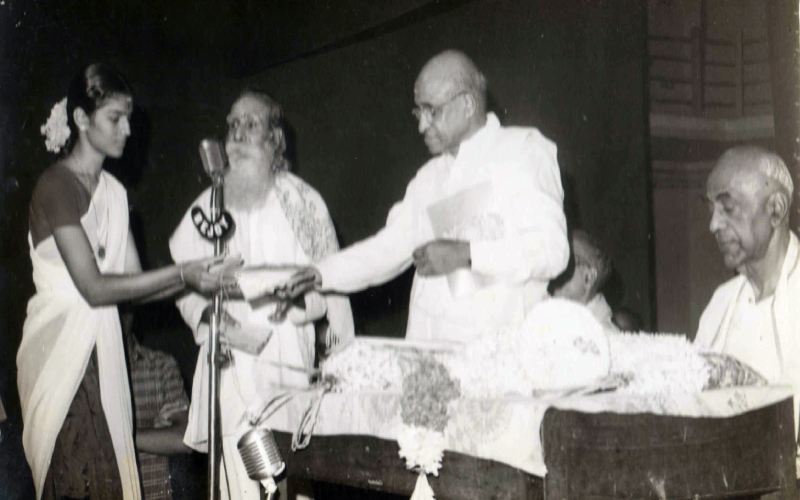
There would be kadhaakaalakshemam programs at Thiruvetteeswarar Temple which took place for 10 days and Sukkanya, as a youngster, would play on all the 10 days for K. C. Thyagarajan. Once the vidwaan was invited to perform a kadhaakaalakshemam at the residence of Kotthamangalam Subbu on his memorial day and she had accompanied him.
The virtuoso emotionally stated the incident of her first rejection being a woman, “Even though I was not very attentive, I could barely hear what they spoke. The host showed platform set up for the performance to K. C. Sir and told him that for the past many years they had not entertained a female mridhangam player and would be pleased if he could find an alternate male artist. This made me a bit anxious and sad. Though K. C. Sir tried to convince me, that kind of rejection was unexpected. I used to think now, how Kotthamangalam Sir had struggled for women’s rights, a stark contrast to what was happening then in his own lineage.”
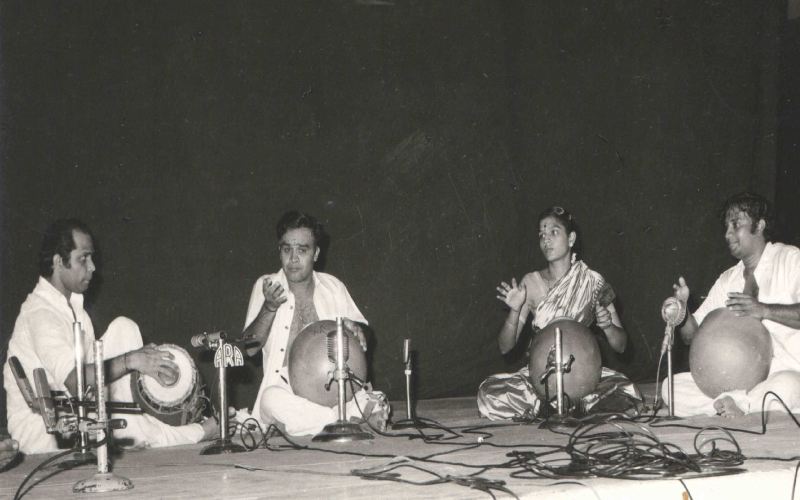
Vidwaan Vikku Vinayakram is undoubtedly a maestro in handling both ghatam and mridhangam. Sukkanya had keenly observed all the applauds, and praises that the maestro would receive and was deeply fascinated. It seems she was mesmerized at the way he handled the instrument. It is true even today, when one observes his beats and the thus produced vibrations, one can be sure of being taken aback.
Sukkanya narrated her wonderment at observing the mridhangam maestro during her childhood days as, “I admired how he created those powerful beats with those hands and on one fine day I approached Vikku Sir with a request to teach me ghatam. He said humbly that I am a girl child and ghatam is a clay instrument which may eat away my untrained tender hands. And continued to persuade me by saying that it is better for me to learn mridhangam instead of ghatam. But I was not ready to take a no for my request. So, I told I would not play ghatam if my beats do not produce musical notes on the instrument.”
“Vikku Sir had told his father that I stand adamant to learn ghatam and had asked his opinion on the same. He had answered that I had learnt to play mridhangam in three years and had suggested Vikku Sir to teach me ghatam as it will be a privilege for their school. He had also pointed that the ghatam does not know whether a man or a woman is handling it. Thus, I got a green signal for my ghatam career, as he had suggested Vikku Sir to teach me the instrument.”
After these incidents, it seems Vidwaan Vikku Vinayakram had to travel to Berkley University and so Harihara Sharma Sir started to teach ghatam to Sukkanya. He had taught her the differences in fingering techniques between mridhangam and ghatam and she had undergone rigorous training to play with it. Finally, he brought Sukkanya to a stage where she could handle the ghatam on her own. And, when Vidwaan Vikku Vinayakram had once returned from his trip, he was amazed to see Sukkanya’s perseverance and ceaseless determination to learn ghatam, started bearing fruits. Call it passion, hard work, or luck, it took her on a long way to where she is now.
The students of Vidwaan Vikku Vinayakram, along with him, used to perform a popular program called Ghatamaala. It is where several musicians with their ghatam-s, which are set in different sruthi-s, are played together, bringing in a harmony which eventually creates a musical enchantment. There is even a gramophone record of the program available where artists like K. M. Vaidyanathan, Vikku Vinayakram, Palakkad V. A. Sundaram, and Subash Chandran had created that musical ecstasy.
The creation of an invisible bond between a teacher and a student is really a blessing. It is only after that bond is well-established the exchange of knowledge takes place. It can be stated as a divine transaction as the teacher is possessed with the thought of developing his students more than him. During the same, the students also learn many other important values for life. This was what called as superficial, irrational, and baseless by the colonial “masters.”
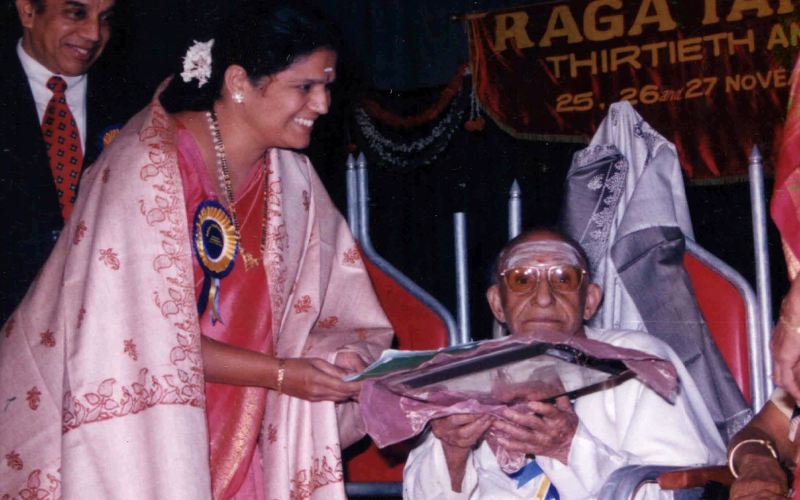
Sukkanya Ramgopal uttered proudly the exceptional lessons that she had learnt by assisting her guru-s in a captivating way. She said, “Harihara Sharma Sir had earlier published a small book on music and later published a big-sized second part of the book for which he would ask me to correct the proofs. He would teach me the pattern first and then ask me to check. As I started doing that, I got to know how to notate a musical pattern, how to write a lesson, and how to notate the thaala-s. It also helped me learn several swara korvai on my own.”
This experience and more similar ones helped Sukkanya Ramgopal publish a book named, ‘Sunadham – The Vikku Bhani of Ghatam Playing’ in 2016. It can be classified as the first book written on ghatam. It was suggested that Vidwaan Harihara Sharma had the vision to take the pride of musical instrument ghatam throughout the world and this book proved to be a dedication to that noble foresight.
“I began to play ghatam in several small stages. I also had an aim to play in the Music Academy and it so happened one day. The invitation that requested me to perform at the Academy had reached the residence of Harihara Sharma Sir. It was a rainy evening and I had just then returned from my college. Harihara Sharma Sir clapped his hands to call me, as we resided in the same street, and told, “Sukkanya you have an invitation from the Music Academy,” and he handed over the letter to me with joy. I instantly turned glad and bounced with enthusiasm. I later gave my performance at the Academy.”
The opportunity is granted by the universe when the aspirant truly seeks for anything with the noble intention and Sukkanya Ramgopal is a living example for that. She reminds us the importance of 3G’s in life to be successful, God, Guru, and Goal. Let us proceed to read and understand what more the first woman ghatam artist has to share with all of us through her experiences.
“I was once invited to play in a Kaccheri (Consort) at Bengaluru. Before the commencement of the program, the secretary of the institute approached me and said that the mridhangam artist was not ready to perform with a woman musician and conveyed his apologies. I felt extremely bad at the rejection showed by that male artist. I even began thinking that why can’t he perform sitting with a woman just for 3 hours? What’s wrong in it? Is he underestimating my abilities to perform with him? Or is he thinking that this can cause disappointment to me?”
All kind of questions had flooded her mind. The ghatam artist spoke with profoundness in her words. She said that joy and merriment of the program increases only when all the musicians perform as a team and associate themselves to be one family. This helps the program reach a different scale of energy level and it develops a positive surrounding. Although she had felt bad initially, it was only later she realized that these experiences had helped her grow in maturity. Also, these had kindled in her the passion to do something new which was not previously done.
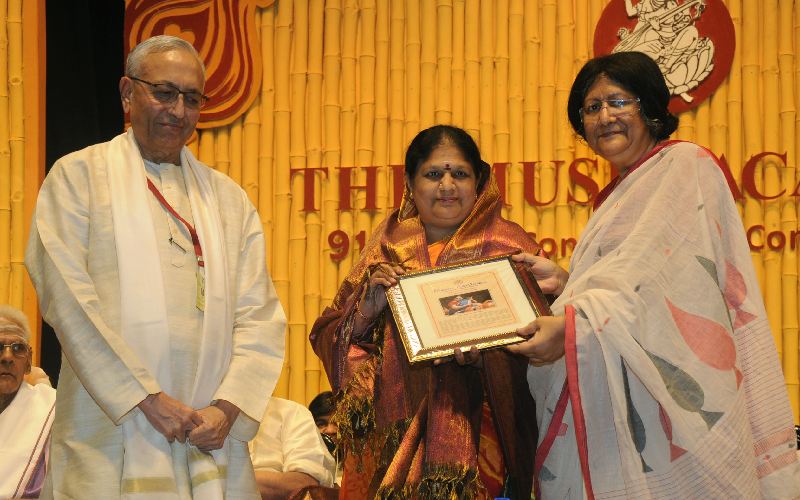
“I perceived a thought about the ghatamaala pattern which could be introduced altogether on a different scale, Sa Re Ga Pa Da Sa in Mohonaraaga, and wanted to implement it. There is an institution named Percussive Art Centre in Bengaluru which was founded by Bangalore K. Venkatram. There would happen many seminars, kaccheri-s, festivals on percussion instruments. I was fortunate to perform my innovation in one of the programs which happened at the Centre. As a youngster, I had also received Putaachaar Award from this institution.”
Sukkanya’s vision had aided her to start a program which brought the hidden potentials of many women artists who were denied the opportunities. She, then, compiled them to a cassette named, ‘Rainbow.’ She accepted the fact that God had put her in such a situation where she would be denied a chance to play with a male artist, just to bring out the best in her and make a mark in the history through these endeavours.
Ghatam is usually treated as an accompaniment instrument to veena, mridhangam, ganjira and violin. It is even called a Oomai vaadhyam (Dumb instrument) as it cannot produce loud music. Despite the fact, her guru, Vikku Vinayakram, made it speak through his way of handling and Sukkanya made it sing through her way. With the grace of God and the guru, the sishyaa brought the ghatam to the centre stage.
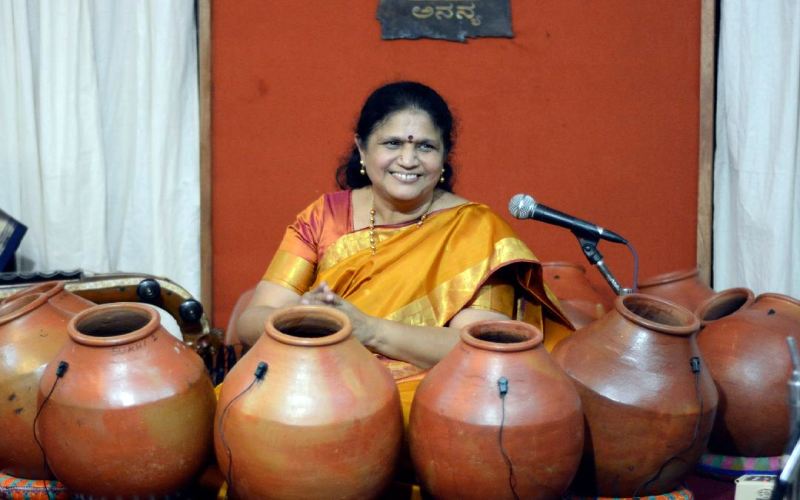
Even though Sukkanya had performed the Shankarabharanam Raaga with 8 ghatam-s and Sriranjini Raaga with 7 ghatam-s around her, she feels playing with 6 ghatam-s to be comfortable. She had even composed many ghatam instrumentals to give freedom for the musicians to create variations. Playing Kalpanaa Swaraa, and several variations in nadai-s were done by her. All these patterns were also taught to her students.
The discrimination against women percussionist artists still prevails in the society which may eventually lead to lack of participation from any new women musicians. Now a days, many great artists and composers want others to listen to their own music and do not give sufficient space to their students. Sukkanya said that it was rather different during the olden times.
“We celebrated Vikku Sir’s 75th birthday with an eighty-four-ghatam ensemble which was a noteworthy and a beautiful event. Apart from ghatam, I loved the konnakol and even wanted to bring out the aesthetics of harmony in it. I feel that many just beat the percussion instruments to produce music, forgetting the fact that only the right touch can create pleasant music. The art of producing the right music is itself an art. My dream is to produce an ensemble of music inviting as many possible women artists in the world,” Sukkanya Ramgopal said humbly.
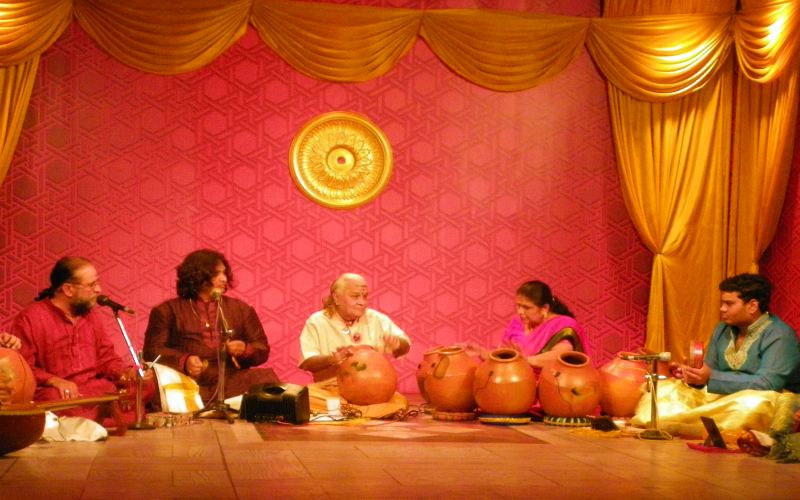
She concluded the conversation by narrating the story of Iyarpagai Naayanaar and pointing out one of her best experiences.
“In the month of January, there would happen a jaathra in a temple located in Koppal village at Bengaluru. There is a resident swamiji at the mutt in the temple. The environs is rugged, full of terrains, and appears rocky. During the jaathra several villagers of the Koppal Village and the nearby villages gather and perform a unique ritual under the guidance of that swamiji called Hejjanamaskaaram. People used to perform namaskaaram-s at every step they take. Even the swamiji would perform that. It will be amazing to notice lakhs and lakhs of people taking part in that function.”
“I was once invited to that village to perform a ghata tharangam along with my team. During the program, I used konnakol to pronounce the words, Shiva Shiva, on random progression and the whole mass gathered there also repeated the Shiva Naama with me. That moment is still unimaginable when the sea of people got involved and made the time additionally auspicious with their chants. Everyone was stunned to see me performing with 6 ghatam-s and even the swamiji appreciated me on behalf of the gathering stating that I had gratified all the devotees there with my performance.”
“Though I accepted the praises, really speaking, I owe all credits to my guru-s. It is because of them I am here. I remember to have been invited there thrice till date. I get goose-bumps even now on recollecting those jiffies.”
Sukkanya Ramgopal, the ace ghatam shikshika, had received the precious Sangeet Natak Akademi Award at Rashtrapathi Bhavan from the hands of Honourable President of India. She had also received T. T. K. Award, and Best Senior Ghatam Artist Award from Music Acadmy, the Best Artist of the Year Award from Bangalore Gayana Samaja, etc.
She had composed jathi-s using konnakol taking the songs of Bharathiar and had created a series of episodes along with her daughter Radha, Chaaru Hariharan from Trivandrum, and student Sumana Chandrashekar from Bengaluru under the theme, “Kaviyin Mettum Sorkattum.” Sukkanya along with her team is planning to release a last album jathi in the episode on Bharathiar’s birthday, December 11, this year. She further has a YouTube channel where she updates many videos regarding her inspirations and the new jathi-s. She also is planning to do a part-by-part recitation of the messages of Dr. U. Ve. Swaminatha Iyer in her channel.

The words and expressions of this legend will leave an unexplainable positive impact in a reader’s heart. One can be sure that this inspiring story will transform one’s life when the optimistic traits are rightly employed. Let’s read many such inspiring lives in days to come at www.TheVerandahClub.com and remember the country’s glories.
“A good family, understanding life partner, encouraging children, and supporting society are also essential for a person to trail the path of success,” the ghatam artist revealed the open-secret towards the end. Her spouse, Ramgopal, had greatly supported her in pursuing her ghatam career even after marriage. From then on Sukkanya has been living a happy life in Bengaluru with her family.
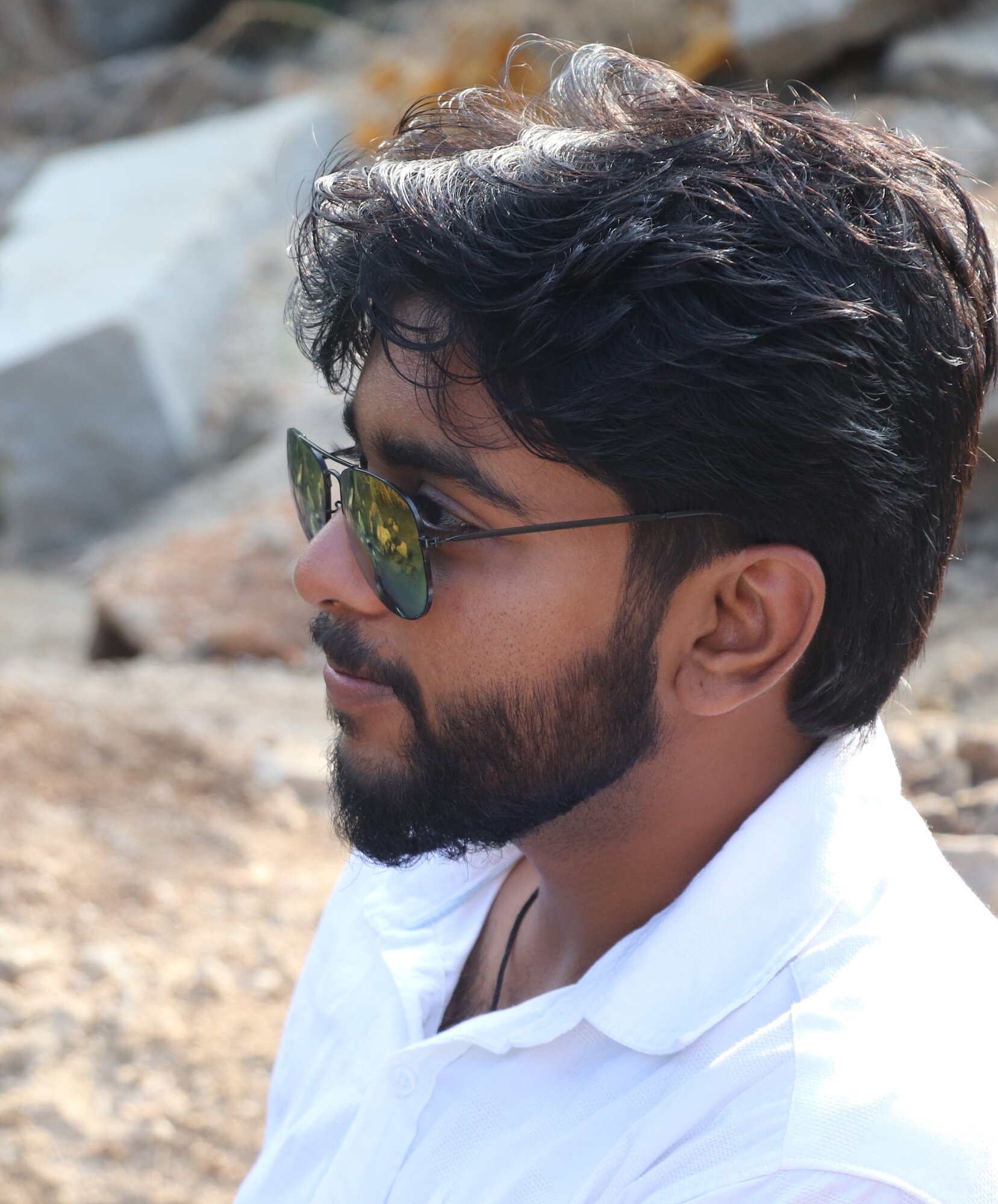
T. R. Surya is the special correspondent of the company. He is an eloquent speaker and compendious writer of English. An avid learner of Sanskrit and Indian scriptures under the guidance of Swami Ganeshaswarupananda and Gita Chaitanya of Arshavidyalaya. His inclination and interests are towards studying Metaphysics and philosophies.
NEXT ARTICLE